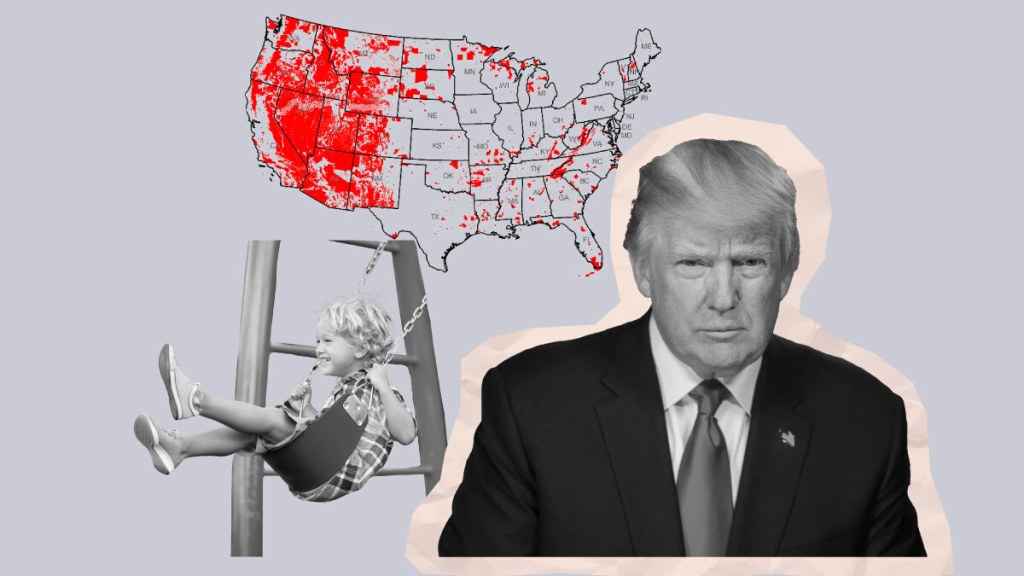
With Donald Trump’s victory now secured, housing advocates and experts are closely watching for signs of what his second term as president could mean for the nation’s growing housing crisis.
Housing was a key topic throughout the presidential election cycle, and it was one of the policy areas discussed by Trump and Vice President Kamala Harris during their September debate. But much is still unknown, including Trump’s nomination for director of the U.S. Department of Housing and Urban Development (HUD), as well as a detailed housing plan.
Throughout his campaign, Trump focused on deregulation, tax cuts and reducing mortgage rates. In speeches, including one at the Economic Club of New York in September and a press conference in August, Trump reiterated his promise to reduce regulatory barriers and vowed to make federal land available for extensive housing projects.
Politico reported in August that proposals to sell federal land to developers for housing construction have notably appeared in both the Republican National Committee’s 2024 platform and in President Joe Biden’s housing plan, when he was still in the running. Harris also included housing construction and affordable housing initiatives in her agenda. Other administrations have attempted this feat, but the plans are easily vetoed.
“I think that, politically, it’s always been easy to kill because people who live near those lands like them nice and empty, and they can oppose affordable housing while enjoying their own as well as the benefit of living near federal lands,” said David Dworkin, president and CEO of the National Housing Conference.
“When we talk about affordable housing, it’s something that people are often happy to have in somebody else’s neighborhood or community, but not their own, and it’s a hypocrisy we see both in blue states and blue communities as well as red ones.”
If the plan were to move forward, the federal government — which controls about 650 million acres of land — would invite developers to bid on parcels, provided they commit to maintaining a percentage of units at affordable rates for local communities.
“We’re generations past the federal government building affordable housing because we found that the private sector does a better job at it and can leverage the investment better,” Dworkin said. “Having the private sector do this work actually makes a lot of sense and that, by definition, means the private sector is going to make a private profit. And there’s nothing wrong with that, as long as the housing is affordable to working-class people.”
Redfin chief economist Daryl Fairweather said that Trump’s plans for housing are “small potatoes” compared to two main policies — neither of which are directly related to housing — that would impact the industry the most. Trump has a tentative plan for tariffs and has repeatedly promised increased levels of deportation of undocumented immigrants.
“A lot of construction labor is undocumented labor,” Fairweather said. “If you look at non-citizens working in the construction industry, according to the census, it’s about a third of construction workers. And it could be quite disruptive. … For the construction industry, that can mean that you think a certain person will show up to work today, and they just don’t show up. So, it’s not even something that can be prepared for.”
The plan is hard to imagine, Dworkin said, because the amount of land that actually can accommodate infrastructure is unknown. But he said the western U.S. has plenty of open land — even in unsuspecting, high-priced areas of the country like San Francisco.
Some federal land isn’t feasible for a host of reasons, said Andrew Jakabovics, vice president for policy development at Enterprise Community Partners. He argues that rural areas should be taken out of the land-use equation.
“[It starts] obviously with environmental impact but also just the cost of trying to build, bringing materials out to the middle of nowhere, and the labor force out to the middle of nowhere, which is not going to be feasible. But there is a lot of federally controlled land that’s already within municipal boundaries, that’s already within metro areas, that is underutilized,” Jakabovics said.
Intention with land use is imperative, he added, but also it’s too soon for the incoming administration to have a plan. “I think it’s about building more in the places where we’ve already got housing and we’ve already got infrastructure and we’ve already got schools and shopping centers, and the amenities that make places livable,” Jakabovics said.
Dworkin agrees that balancing developers’ profit motives with sensible land use is critical. “Developers will naturally target the most viable opportunities,” he said. “The government needs a process that’s fair, equitable and efficient.”
The need for affordable housing is pressing. “Homelessness grows daily, fueled by the lack of affordable housing,” Dworkin noted. “Addressing this crisis requires building more affordable housing in places where it’s needed — not just in coastal cities but in places like Phoenix, Boise, Omaha and Nashville.”
Jakabovics said that using federal land for the purpose of building more homes hasn’t worked on a wider scale before because state and federal officials are playing hot potato with the issue of affordable housing.
“[Land use] has largely been seen as a state and local issue. We’ve typically left the development to the market to produce, you know, and even the way we build affordable housing right is through incentivizing the private sector to build right with targeted affordability,” he said.
Fairweather is doubtful that Trump’s plan could come to fruition. “If you look at [Agenda] 47, he specifically says he doesn’t want to bring low-income housing to the suburbs. So, I don’t think he’s talking about putting subsidized housing on post offices, the way that Harris was,” she said. “And builders are very profit motivated, and I’m not sure how much of federal land has market value.”
In a related development, the Biden-Harris administration last month announced the sale of 20 acres of public lands, for just $100 per acre, to build affordable housing projects in southern Nevada. The Bureau of Land Management sold the land, valued at nearly $20 million, to Clark County for $2,000.
The county plans to develop 210 single-family homes for households earning $70,000 or less. Located in southwest Las Vegas, the project known as Cactus Trails will also create more than 100 jobs.
“There’s a lot of bipartisan ground to make progress on — and this is one of them,” Dworkin said.





